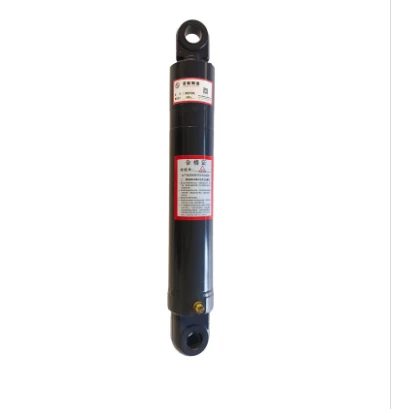Nov . 07, 2024 06:26 Back to list
Revamping and Restoring a Hydraulic Cylinder for Optimal Performance
Rebuilding a Hydraulic Cylinder A Comprehensive Guide
Hydraulic cylinders are fundamental components in various machinery, playing a crucial role in converting hydraulic energy into mechanical force. Over time, these cylinders may experience wear and tear, leading to diminished performance or even failure. Rebuilding a hydraulic cylinder can restore its function and prolong its life, saving costs compared to purchasing a new one. This article outlines the steps involved in rebuilding a hydraulic cylinder and the considerations to keep in mind throughout the process.
Understanding the Components
Before diving into the rebuilding process, it is essential to understand the main components of a hydraulic cylinder. A standard hydraulic cylinder consists of the following parts
1. Cylindrical Barrel The outer shell that houses the internal components. 2. Piston A movable component that divides the cylinder into two chambers. 3. Rod An extension that links the piston to the machinery and transmits the force generated by hydraulic pressure. 4. Seals and O-rings These ensure that hydraulic fluid remains contained and prevents leaks. 5. End Caps These are found at both ends of the cylinder, securing the components inside.
Assessing the Damage
Before rebuilding, the first step is to assess the hydraulic cylinder's condition. Common signs of wear include
- Leaking hydraulic fluid - Difficulty in extending or retracting the piston - Unusual noises during operation
Carefully inspect all components for signs of damage such as scoring on the cylinder barrel, wear on the piston, and deterioration of seals. Identifying the extent of the damage will help determine whether parts can be repaired or must be replaced.
Disassembling the Hydraulic Cylinder
Once the assessment is complete, it's time to disassemble the cylinder. Follow these steps
1. Safety First Ensure that the machine is powered off and properly secured. Relieve any hydraulic pressure before beginning.
2. Remove the Cylinder Disconnect the hydraulic lines and carefully remove the cylinder from its mounting.
3. Disassemble the Components Start with the end caps. Use a wrench to remove them, and gently slide the piston out of the barrel. Take care not to scratch the surfaces during this process, as this could compromise seal integrity.
rebuilding a hydraulic cylinder product

4. Organize Components Lay out all disassembled parts in an organized manner. This will simplify the reassembly process and help you track which parts need replacement.
Cleaning and Inspecting
With all the components removed, it’s time to clean them thoroughly. Use a suitable solvent to remove dirt, grime, and old hydraulic fluid. Pay special attention to the barrel; any debris left inside can hinder performance.
As you clean, closely inspect each part again for wear or damage. Check the seals and O-rings for signs of cracking or hardening, and replace them if necessary. If the barrel or piston shows extensive wear, you may need to consider honing or replacing them.
Reassembly
Once everything is clean and inspected, it’s time to reassemble the hydraulic cylinder
1. Replace Seals and O-rings Start with the seals and O-rings, ensuring they are properly lubricated with hydraulic oil before installation. This reduces the chances of tearing during assembly.
2. Reinsert the Piston Carefully slide the piston back into the barrel, making sure it is aligned correctly.
3. Secure End Caps Reattach the end caps, tightening them to the manufacturer’s specifications to prevent leakage.
4. Final Checks Double-check all connections and components to ensure everything is in its proper place and secure.
Testing the Rebuilt Cylinder
With the hydraulic cylinder reassembled, it’s essential to conduct a thorough test before fully reintegrating it into the machinery. Connect the cylinder to the hydraulic system and gradually pressurize it. Look for any signs of leakage and listen for abnormal sounds. The cylinder should move smoothly without hesitation.
Conclusion
Rebuilding a hydraulic cylinder can be a cost-effective way to extend the life of your equipment. By carefully assessing the damage, meticulously cleaning and inspecting components, and thoughtfully reassembling everything, you can bring a hydraulic cylinder back to optimal function. Always ensure safety measures are in place and follow manufacturer specifications whenever possible. With the right approach, rebuilding hydraulic cylinders can not only save money but also enhance the efficiency of your machinery.
-
1.5 Ton Lifting Cylinder 70/82-40-290-535 - Hebei Shenghan | Precision Hydraulic Solutions
NewsJul.29,2025
-
1.5-Ton Lifting Cylinder 70/82-40-290-535 - Hebei Shenghan Hydraulic Machinery Co., Ltd.|Heavy-Duty Lifting, Precision Engineering
NewsJul.29,2025
-
1.5 Ton Lifting Cylinder 70/82-40-290-535 - Hebei Shenghan | Heavy-Duty Hydraulic Solutions
NewsJul.29,2025
-
1.5 Ton Lifting Cylinder 70/82-40-290-535-Hebei Shenghan|Heavy-Duty Hydraulic Solutions&Precision Engineering
NewsJul.29,2025
-
1.5 Ton Lifting Cylinder 70/82-40-290-535 | Precision Engineering&Industrial Applications
NewsJul.21,2025
-
1.5 Ton Lifting Cylinder 70/82-40-290-535-Hebei Shenghan|Hydraulic Solution, Industrial Applications
NewsJul.21,2025
